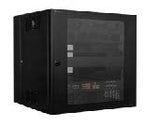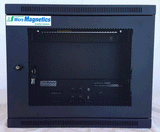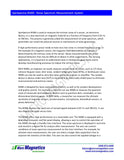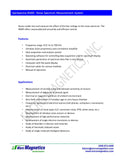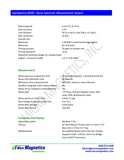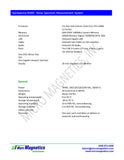The SpinSpectra-NSMS is a noise spectrum measurement system capable of measuring the intrinsic noise of a sensor, an electronic device, or a new electronic or magnetic material as a function of frequency from 0.01 Hz to 700 kHz. This process is generally called the measurement of noise spectrum, which potentially can reveal the physical sources for mechanisms of noise generation. An engineer can use the SpinSpectra-NSMS to measure various kinds of noises, such as 1/f noise, Johnson-Nyquist noise, Shot noise, random telegraphy noise (RTN), or Barkhausen noise. The SpinSpectra-NSMS can also be used as an ultra-low noise spectrum analyzer or amplifier.
The SpinSpectra-NSMS is designed for basic and applied research, as well as for product development and quality control. For example, a scientist can use it to measure the quantum noise of nanoscale semiconductor devices such as quantum dots, nanotubes, or two dimensional electron gases. In R&D fields, a researcher can measure the ultimate sensitivity of magnetic sensors, accelerometers, microphones, biomedical sensors, or photo-detectors.
The SpinSpectra-NSMS displays the spectrum of sensed signals between 0.01 Hz and 700 kHz. It fan also display the noise versus time.
The SpinSpectra-NSMS offers high performance at a reasonable price. It's equipped with a computer and flat-panel display, allowing user to control the operation of the NSMS through a friendly User-Interface. The noise spectrum is displayed in real-time and stored in a digital file for analysis after measurement. User can control conditions of the noise spectrum measurement on the User-Interface. For example, for ultralow noise measurement, user can select a longer data acquisition time to improve the statistics of data. User can also control the applied voltage to a device under test and measure the effect of the bias voltage to the noise spectrum. The SpinSpectra-NSMS offers unprecedented versatility and efficient control.
Features:
- Self-calibration of Noise Spectrum: The SpinSpectra-NSMS has a built-in white noise spectrum generator as a standard. This allows the system to be self-calibrated over the whole frequency range. Once the self-calibration is activated, the system will measure the gain of the system's electronics and compare the measured spectrum with the standard spectrum. The operating software will normalize the gain function so that the measured noise spectrum is absolutely calibrated. This easy operation give the user assurance that the NSMS always generates the correct amplitude of noise across the whole frequency range.
- Input Channel: The SpinSpectra-NSMS has a differential input with 4 nV/√Hz input noise. A line filter (50 Hz or 60 Hz) and a 2x line filter (100 Hz or 120 Hz) can be selected to reduce the power line related interference.
- Auto-correlation Amplification: To eliminate non-intrinsic noises and interference, the SpinSpectra-NSMS uses auto-correlation amplifier circuitry. Autocorrelation is the cross-correlation of a signal with itself. Using this method, only the intrinsic electric noises of the DUT are amplified for measurement, whereas extrinsic noises (interference, circuit noise, etc.) are rejected by the amplifier. With auto-correlation, the system is capable of measuring ultra-low noise.
- Immunity to External Interference: The SpinSpectra-NSMS is equipped with an electromagnetic shielding enclosure to reduce the external electromagnetic field interference. The DUT is mounted inside a conductive enclosure known as Faraday cage, which is included in the package. The coupling between the DUT and the SpinSpectra-NSMS is well designed and configured to reduce the external interference. Following a standard procedure, a user can connect the DUT to the system without much concern on external interference. In noise measurement, external interference can be hindrance in extracting the intrinsic noises generated by a DUT. The SpinSpectra-NSMS is strongly immune against external interference.
- Low Noise Rechargeable Battery Operation: The noise from a power supply can often affect intrinsic noise measurement. The SpinSpectra-NSMS is equipped with a rechargeable battery to power the system during operation. The battery eliminates potential noises from the power supply, enabling the system for ultralow noise measurement. The battery is automatically charged when the system is not in use. The battery is also used to bias the DUT if needed.
- Computer Control and Display: The SpinSpectra-NSMS is fully controlled by an industrial-strength window based computer with a large flat panel display. The SpinSpectra-NSMS' operating software controls the self-calibration process and the whole noise spectrum measurement. It provides the user with a complete set of functions and control parameters. It allows the noise spectrum to be displayed in different format (varying scales and frequency range, etc.). Because of the large memory provided by the computer, the SpinSpectra-NSMS can record noise spectrum over long time to improve data statistics. The high processing power of the computer allows the user to perform fast data acquisition and after-measurement thorough analysis on noise spectrum.
- Easy Operation: The SpinSpectra-NSMS is simple to use. All functions are set on the computer's User Interface, and measurement parameters and conditions are displayed on the large flat panel. The noise spectrum data is automatically saved on the computer.
Applications:
- Measurement of intrinsic noise and ultimate sensitivity of sensors
- Measurement of spectrum of sensed signal
- Electrical or magnetic spectrum of ambient environment
- Zero field confirmation in Faraday cage or zero Gauss chamber
- Frequency spectrum of electrical sources (cell phones, computers, instruments, etc.)
- Determination of noise types (1/f noise, Lorentzian noise, random telegraphy noise, white noise, etc.)
- Development of ultra-low noise sensors or devices
- Development of high performance materials
- Development of single-electron transistors or devices
- Study of disorders in devices and materials
- Study of thermally induced noises
- Study of single-molecule biological detectors
Specifications:
Input Channel:
- Voltage input: Differential
- Bandwidth (-33dB): 0.01 Hz to 700 kHz
- Sensitivity: 4 nV
- Noise (typical): 4 nV/√Hz at 10 Hz
- Gain accuracy: ±1%
- Line filtration: 50 Hz or 60 Hz and 100 Hz or 120 Hz
- ADC resolution: 16 bits
- Maximum sample rate: 1.00 MS/s multichannel (aggregate)
- Minimum sample rate: NA
- Timing accuracy: 50 ppm of sample rate
- Timing resolution: 10 ns
- Maximum working voltage for analog inputs (Signal + common mode): ±11 V of AI GND
- Noise spectrum acquisition time: 30 seconds (typical), 1 second (minimum)
- Noise self-calibration time: 30 seconds
- Minimum noise measurement: 300 Ohm Johnson noise effective
- Random telegraph noise measurement: Yes
- Noise versus frequency measurement: Yes
- Noise type: 1/f noise, Johnson-Nyquist noise, Shot noise, RTN, Barkhausen noise
- Noise spectrum chart scale: Linear or Log
- Bias voltage to Device-under Test (DUT): 0-15 V
- Noise data storage: continuous
- Noise data format: Text file
- Power: 300 W, 100/120/220/240 VAC, 50/60 Hz
- Dimensions: 20.5" x 26.4" x 22.6"
- Weight: ~ 150 lbs
- Operating temperature: 0-50°C
- Storage temperature: -40°C to 70°C
- Operating humidity: 10 to 90% RH, noncondensing
- Storage humidity: 5 to 95% RH, noncondensing
- Indoor use only
- Warranty: one year parts and labor on defects in materials and workmanship












